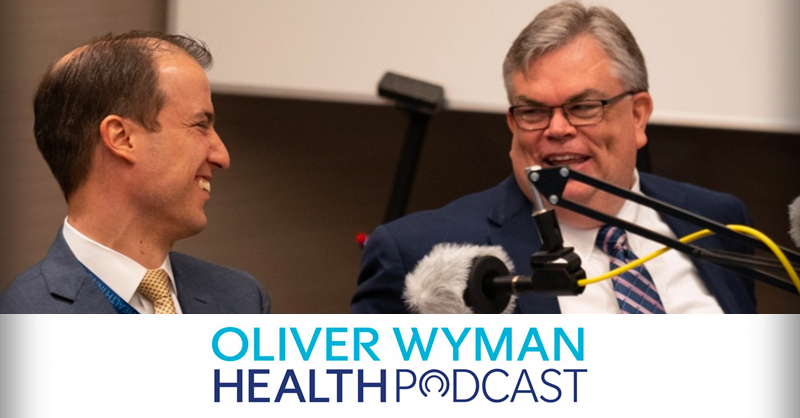
Healthcare Transformation – Parts 1 and 2
On these episodes of the Oliver Wyman Health Podcast, Bryce Bach, Principal in Oliver Wyman’s Health & Life Sciences Practice, sat down with Mike Farris, Navvis’ Chairman and Chief Executive Officer, and Carter Dredge, SSM Health’s Chief Transformation Officer, at the Oliver Wyman Health Innovation Summit in Chicago to learn more about how this partnership started, what they’re committed to tackling next, and why new business models are required to engender sustainable and transformational change.
Editor’s Note: This podcast covering Navvis and SSM Health’s new partnership is a two-part series, offering our listeners an in-depth perspective on how both organizations are aligned to deliver innovation and new models of care in SSM Health’s markets. Part 1 discusses the six pillars essential for transformation and advice for executives looking to collaborate and transform in similar ways. Part 2 offers a detailed look at their transformation agenda.
Memorable Moments From This Podcast
- “Health is not just the absence of infirmity or disease. It’s the social, the emotional, the spiritual, and the physical domain that has to be addressed when dealing with health.”
- “We as a healthcare system, for too long in the conventional sense, have done a very good job of telling people what’s the matter with them. We’ve spent billions of dollars [on] high-tech diagnostic capabilities. We’ve intervened surgically at times to save people’s lives. All very wonderful things and tremendous capabilities in this great nation of ours. But one thing we’ve failed to remember is that we’re all sentient beings. We are emotional, we are social, and we have real life circumstances. And so while we tell people, ‘What’s the matter with you?’ we’ve lost the concept of really understanding, ‘What matters to you?'”
- “What is ‘population health’? It’s meeting people where they are and helping them live their best lives, which by the way, isn’t that 20 minute office visit or that three-day length of stay. It’s what goes on in between visits.”
- “You have to figure out where the current state of affairs may be, define what that future state needs to look like, and then decide how do you pace and sequence from the current state to that desired future state. And what will be the strategies we deploy to close that gap.”
- “For any organization (it doesn’t matter how deep their pockets are), if in the end the business model that they’re creating isn’t self-sustaining, it’s not going to grow fast enough. I’m always interested in focusing on who solved the business model problem, not just as a fancy idea or a fancy piece of technology, but do they have a self-sustaining business model?”
- “We are going to fundamentally change the way healthcare is delivered in the markets where SSM resides. We’re not going to stop until we achieve it. And Navvis is not just a key partner. They’re a critical partner.”
- “We have very strong goal setting inside of SSM that says we really want to dramatically reduce the cost of people pay for healthcare, getting higher quality, getting a better experience. And it’s going to be step-wise. But to do this, you fundamentally need a different type of operating system. A lot of patient interactions happen outside of your actual facilities as a healthcare provider, and our current records, electronic medical record, or we call it a system of record, is not really designed for all of those other non-acute or even non-ambulatory types of touchpoints. To do something at scale, we have to have an operating system be able facilitate that model at scale and excel spreadsheets and Post-It notes are not going to cut it when you’re talking about thousands and thousands of people.”
- “We are now in a position where we’re going to be able to have a model of density. Hundreds of thousands of people are going to be affected and that creates that model of density of the population. This is the responsibility to really deal with a longitudinal population across all payers, across all lines of business, socioeconomic circumstances, and all social needs. That’s what’s really exciting to us, and that’s the transformation hard work we’re all bought into.”
- “It’s really important when we talk about how we make these transformational changes stick and not just be more transitory than transformational. It comes down to business models, not just services. And we really do need to, as an industry, talk more about business models and less about services. Oftentimes when we talk about services, we keep the core construct of how we do things the same and we add on or we just slightly augment what we do in just a slightly nuanced way, heavily focused on incremental type of activity. When we talk about a new business model, we really are rethinking a construct. How does the revenue and the pricing model work? What does the technology look like and what’s the product strategy? Who do we hire? What are those core competencies? What do patients truly need? What are distribution channels? And we go through all of these questions and the reality is if we’re going to make something transformational, it ultimately has to be self-sustaining.”
- “The thing that is exciting is we’re solving this problem of volume and value. It’s not an or, it’s not volume or value, it’s the power of and it’s how do we have volume-based growth through value based performance. No matter what stage the market is in, because therein lies the ability to get to transformation.”



